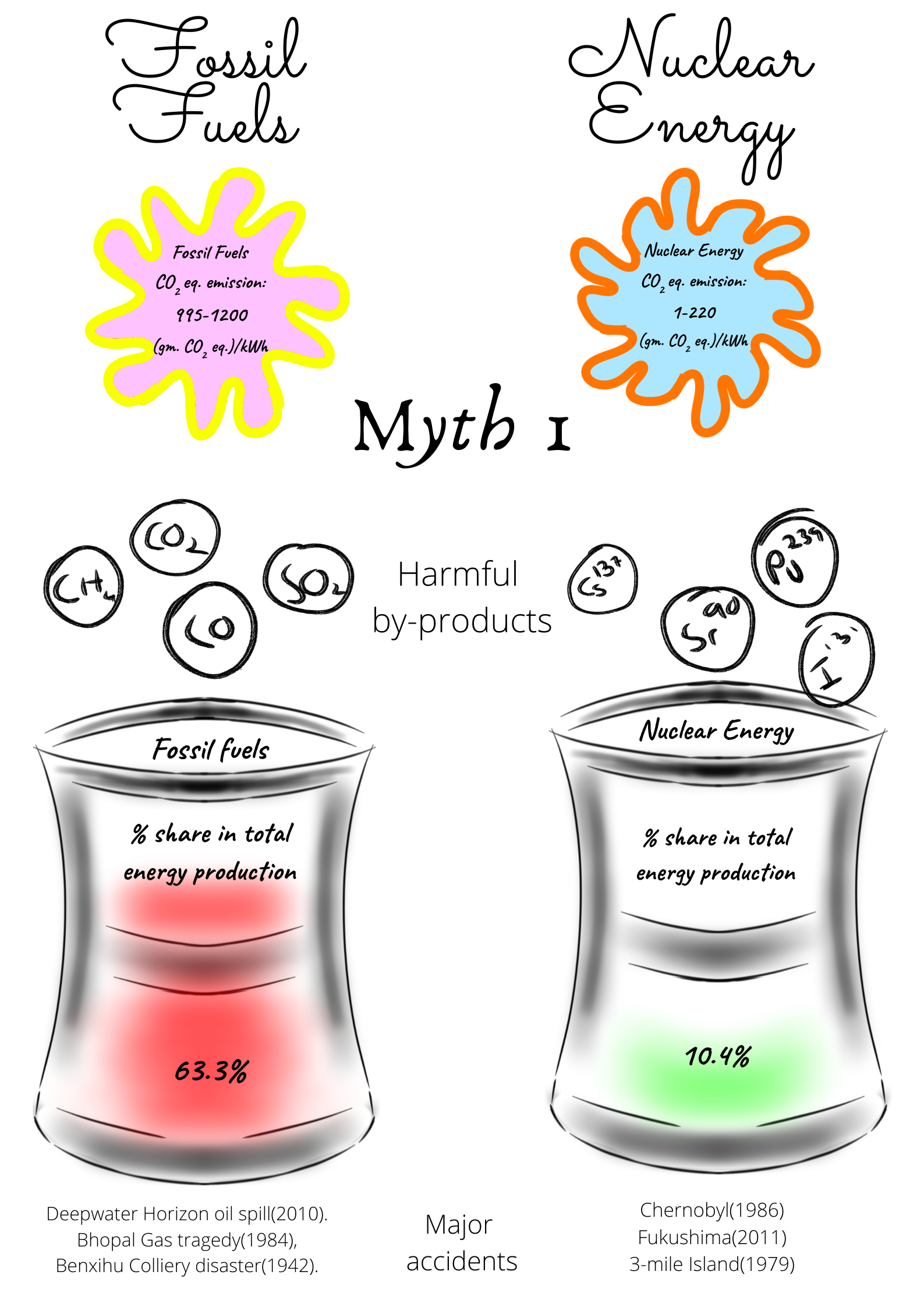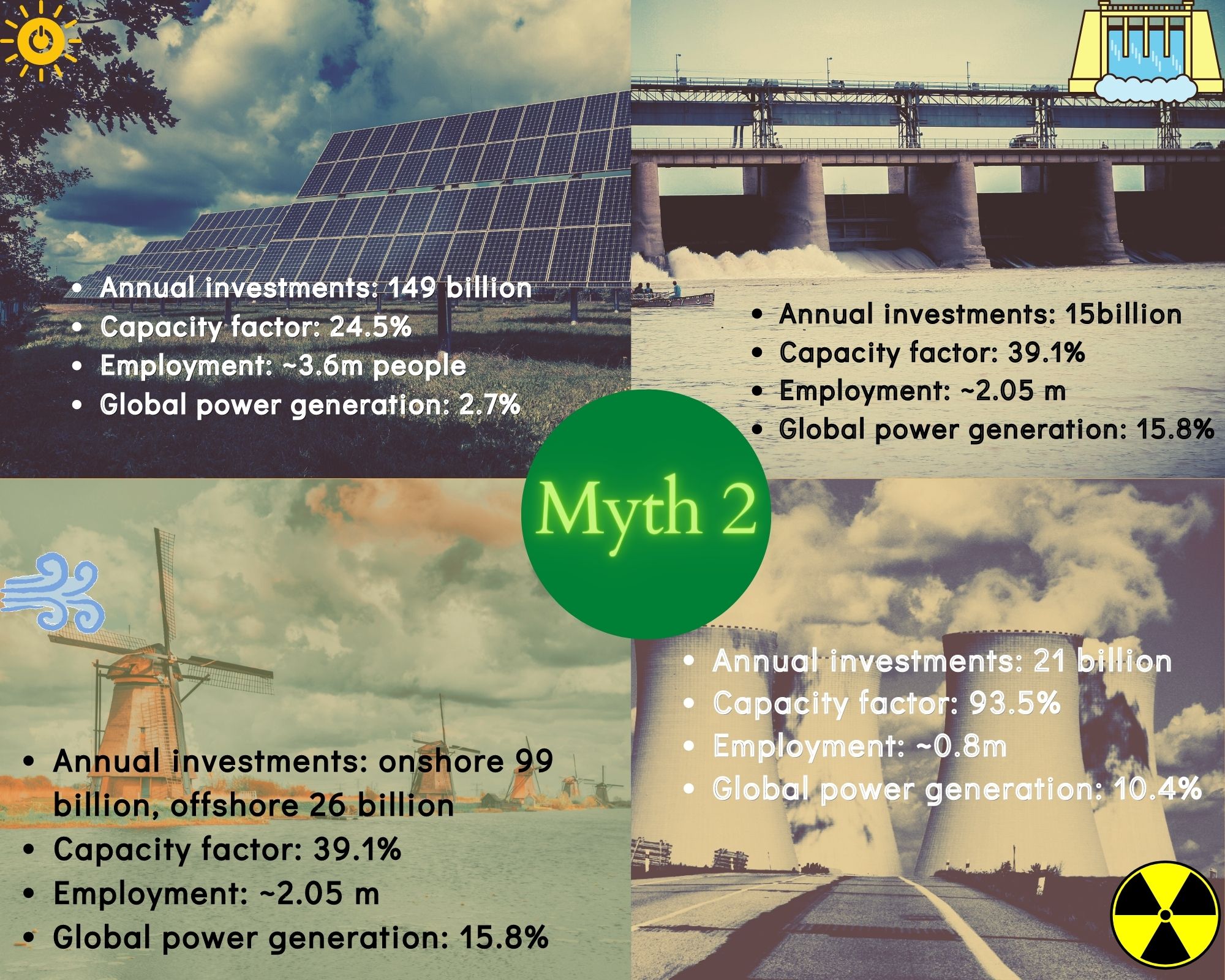Debunking the Myths
As suggested in our title, Nuclear Energy? Is it a green source of energy ,rather, is it truly a way forward?
Well,that’s a question each one should ask themselves, the ones who absolutely believe in the ideology of powering the world with green sources of energy and gradually minimizing the hazardous effects of fossil fuel energy that is accounted for a large proportion of the climate change. Just like any other source of energy ,nuclear energy also bears it own pros and cons .There’s nothing in the world that comes without a risk, it is only up to us, given the choice that we have ,to make the right one and learn from our faults. Given the surge in technology ,pioneering ideas in the field of energy and the digital age upon us what better than to utilize the resources to the fullest only for the better. The question to the world out there is are we entirely harnessing the full potential of the green energy sources? Then why are we still highly dependent on fossil fuel energy? These are questions that we leave you to ponder on.
As we dive right into nuclear energy, the first thought to have struck everyone’s mind could probably be oh!radiation,nuclear wastes! Not economical! , perhaps, even a no way! However we may sometimes fail to understand why we are filled with such reservations. Alongside development of ingenious & sophisticated technologies, there must and should a word of awareness with empirical proven facts & figures. When we aren’t aware how will the world progress in unity? It is far better to know the right facts and make a choice rather than not knowing at all. Taking all this into account an effort has been made to address certain myths that have been tagged with nuclear energy for far too long.Being able to enlighten even the smallest proportion of the total population would mean being able to contribute to the world as we leave it with a choice.
MYTH 1 : NUCLEAR ENERGY CANNOT BE REPLACED WITH FOSSIL FUELS
This addresses the fact that the utilization of fossil fuel energy is still on the high and the current renewable energy sources are not sufficient to account for a larger share of electricity generation. Nuclear energy despite ,the very many benefits that it offers ,are still not considered as sufficient pros to replace fossil fuel energy. Another aspect is that of costs and expertise required in this field which is why a lot of reservations are held. We’re going to be busting this myth by presenting facts based on parameters such as CO2 emissions, particle release, waste disposal recyclability, etc.

Impact on human health
- Type of air pollution known as fine particulate matter,
- Condensed liquid droplets that are often the by-product of burning fossil fuels.
- After traveling down the human windpipe, fine particulate matter penetrates deep into the interior of the lungs, triggering inflammation that causes or exacerbates a wide variety of respiratory ailments, some of which can be fatal.
- The smallest bits also manage to enter the bloodstream, where they set off a chain reaction that can lead to heart attacks, cancer, and stroke.
- This is the kind of impact which occurs on a daily basis.
- Here radiation from the radioactive elements are what affect humans and not GHGs.
- Can be transferred to humans from the air and by consumption of contaminated milk and leafy vegetables, becomes localised in the thyroid gland. Caesium-134 and 137 cause longer-term exposure through ingestion and through external exposure from their deposition on the ground.
- Immediate and short-term effects: radiation sickness and cataracts.
- Late effects: thyroid cancer, leukaemia(blood cancer) and possible non-malignant disorders.
- However all this is likely to occur in case of a nuclear blast but not otherwise.
Waste and disposal
- Petroleum coke combustion wastes.
- Waste from the combustion of oil,natural gas.
- Most of these wastes are disposed off into landfills thereby affecting the quality of soil and groundwater and releasing harmful gases .
- Coal mining operations wash acid runoff into streams, rivers, and lakes and dump vast quantities of unwanted rock and soil into streams. Since the start of the Industrial Revolution (and our coal-burning ways), the ocean has become 30 percent more acidic.
- Oil spills and leaks during extraction or transport can pollute drinking water sources and jeopardize entire freshwater or ocean ecosystems.As the acidity in our waters goes up, the amount of calcium carbonate—a substance used by oysters, lobsters, and countless other marine organisms to form shells—goes down. This can slow growth rates, weaken shells, and imperil entire food chains.
- There is no way of recycling the wastes that are generated hence is a matter of concern.
- As per the current practices and technology U235 being the actual fissile material which forms 0.71% of the natural uranium U238 after enrichment to approximately 4 %,undergoes fission to generate electricity. The remaining 96% of the natural uranium U238 potentially becomes a waste for disposal.
- Currently there are two methods adopted for disposal based on the concentration of radioactivity.
- The low level wastes mostly consist of contaminated protective gears, reactor water treatment residues, etc, disposed of to the near-surface repositories (usually 10m under the earth surface).
- high level wastes /long lived intermediate wastes mainly consist of spent fuel, isotopes of uranium 238 and plutonium which are stored in the deep geological repositories(about 500 meters below the earth surface). These high level wastes are the main focus of our concern in terms of their adverse environmental impact.
- The waste here ,although hazardous radioactive wastes can be minimized to the maximum extent if recycling of the unused material takes place.
Reserves and Consumption
Here is the representation of the total number of fossil fuels and uranium reserves that have been present so far and to what extent it is being exploited/consumed .The lengths on the batteries indicate the number of years for which it can still be used.The metrics taken into consideration are tonnes.However when we consider individual batteries it can be observed that oil and coal reserves are being exploited way more than the uranium reserves and that is particularly indicated by the red bars:most exploitation & green bars:least exploitation.
- CO2 equivalent emissions are far less in nuclear energy than energy production by fossil fuels.
- Both have substantial impact on human health.
- Number of accidents in the field of nuclear energy have been less so far.
- Contribution of nuclear energy in GHGs is negligible.
- Most of the particles released from the fossil fuel plants lead to short term health impacts whereas the radionuclides released from the nuclear energy production lead to long term effects depending upon the half-lives.
- Fossil fuels cannot be replenished nor recycled ,however nuclear fuel can as only 0.7% or the fuel is actually utilized for the process of fission for energy production and rest is considered as waste ,given the potential to recycle ,efforts must be made to harness energy even from the waste that is generated.Recycling will surely help prevent the burden on the environment.
- We can establish from the given data that coal, natural gas and oil reserves are exploited much more than nuclear reserves as it has the potential to last for a longer period.
MYTH 2 : SOLAR ,WIND & HYDRO ENERGY ARE SUFFICIENT TO POWER THE WORLD

Without any doubt, these renewable energy resources are more environmental friendly as compared to fossil fuel energy .This would totally account for 28% of the total electricity that is generated from solar wind and hydroelectric energy. However fossil fuels energy still account for the single largest source of electricity i.e. around 63.3%.To be able to fill in the gaps and reach at least half the electricity production from green energy sources nuclear energy is a source that can provide that support and will help compliment the other sources of energy to reach that goal.
Below is a mind map as to understanding the solar,wind ,hydro and nuclear based on the following parameters i.e.,annual investments,social impact,capacity factor and the percentage share of these energy sources.The entire objective of considering this particular set of data is its ability to correlate with the fact that nuclear energy could have the potential to complement the other renewable energy sources.The approximate figures that have been mentioned ,in a way ,allows people to understand the current status and thereby areas of improvement in the near future.
There is a high potential for increase in annual investments in the field of nuclear energy given its high capacity factor, lesser restrictions In terms of land occupation, and less dependence on weather conditions;Unlike solar and wind that are highly dependent on sunlight and an efficient rate of wind,nuclear energy on the other hand can be harnessed without any specific weather dependency. It is essential that to prevent the drastic effects of climate change we must try and adopt all possible ways of clean energy and to be open to newer ways of approaching a problem and given the benefits that it offers,by safe understanding and maintenance nuclear energy could be one of the solutions.
Lastly,Awareness leads to knowledge and knowledge leads to employment and thereby increase in investments. So investments in cleaner and greener technologies could lead to a better outcome.
MYTH 3 : PEOPLE ARE AFRAID OF NUCLEAR ENERGY

This being one of the most important myths, is something that must be given a lot of importance to. Ensuring that the world is on the constant know -how about the happenings in the field of nuclear energy. It is a subject ,that has various facets to it and making sure that they are addressed the right way by the associated organizations is a must. Considering this a survey was taken up titled nuclear energy: a way forward? With 5 crucial questions that matter most. This has assisted us in understanding a global perspective of nuclear energy solutions. Initially it was considered that people in general were too afraid to accept nuclear energy ,however, surprisingly the results show otherwise.





